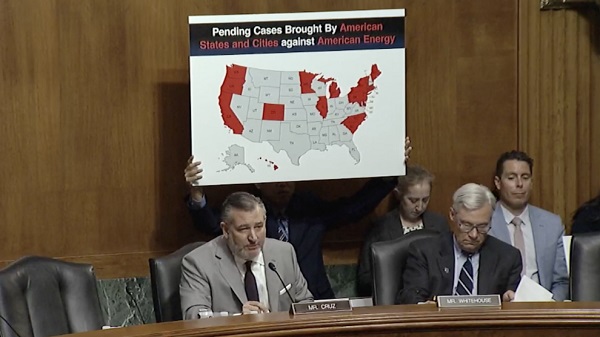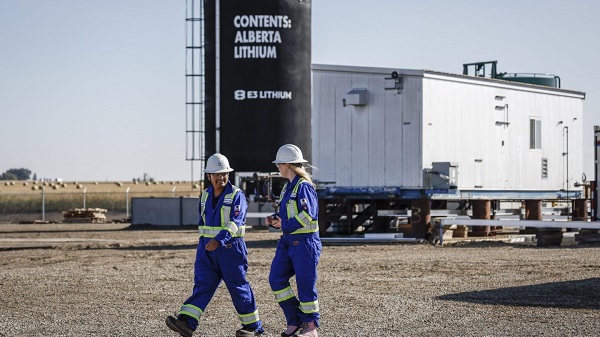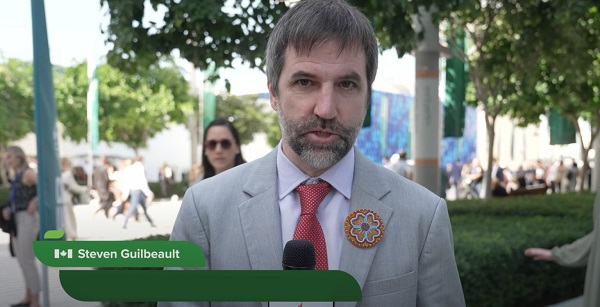Energy
China undermining American energy independence, report says

From The Center Square
By
The Chinese Communist Party is exploiting the left’s green energy movement to hurt American energy independence, according to a new report from State Armor.
Michael Lucci, founder and CEO of State Armor, says the report shows how Energy Foundation China funds green energy initiatives that make America more reliant on China, especially on technology with known vulnerabilities.
“Our report exposes how Energy Foundation China functions not as an independent nonprofit, but as a vehicle advancing the strategic interests of the Chinese Communist Party by funding U.S. green energy initiatives to shift American supply chains toward Beijing and undermine our energy security,” Lucci said in a statement before the Senate Judiciary Subcommittee’s hearing on Wednesday titled “Enter the Dragon – China and the Left’s Lawfare Against American Energy Dominance.”
Lucci said the group’s operations represent a textbook example of Chinese influence in America.
“This is a very good example of how the Chinese Communist Party operates influence operations within the United States. I would actually describe it as a perfect case study from their perspective,” he told The Center Square in a phone interview. “They’re using American money to leverage American policy changes that make the American energy grid dependent upon China.”
Lucci said one of the most concerning findings is that China-backed technology entering the U.S. power grid includes components with “undisclosed back doors” – posing a direct threat to the power grid.
“These are not actually green tech technologies. They’re red technologies,” he said. “We are finding – and this is open-source news reporting – they have undisclosed back doors in them. They’re described in a Reuters article as rogue communication devices… another way to describe that is kill switches.”
Lucci said China exploits American political divisions on energy policy to insert these technologies under the guise of environmental progress.
“Yes, and it’s very crafty,” he said. “We are not addressing the fact that these green technologies are red. Technologies controlled by the Communist Party of China should be out of the question.”
Although Lucci sees a future for carbon-free energy sources in the United States – particularly nuclear and solar energy – he doesn’t think the country should use technology from a foreign adversary to do it.
“It cannot be Chinese solar inverters that are reported in Reuters six weeks ago as having undisclosed back doors,” he said. “It cannot be Chinese batteries going into the grid … that allow them to sabotage our grid.”
Lucci said energy is a national security issue, and the United States is in a far better position to achieve energy independence than China.
“We are luckily endowed with energy independence if we choose to have it. China is not endowed with that luxury,” he said. “They’re poor in natural resources. We’re very well endowed – one of the best – with natural resources for energy production.”
He said that’s why China continues to build coal plants – and some of that coal comes from Australia – while pushing the United States to use solar energy.
“It’s very foolish of us to just make ourselves dependent on their technologies that we don’t need, and which are coming with embedded back doors that give them actual control over our energy grid,” he said.
Lucci says lawmakers at both the state and federal levels need to respond to this threat quickly.
“The executive branch should look at whether Energy Foundation China is operating as an unregistered foreign agent,” he said. “State attorneys general should be looking at these back doors that are going into our power grid – undisclosed back doors. That’s consumer fraud. That’s a deceptive trade practice.”
Alberta
Alberta’s E3 Lithium delivers first battery-grade lithium carbonate

E3 Lithium employees walk through the company’s lithium pilot plant near Olds
From the Canadian Energy Centre
E3 Lithium milestone advances critical mineral for batteries and electrification
A new Alberta facility has produced its first battery-grade lithium carbonate, showcasing a technology that could unlock Canada’s largest resources of a critical mineral powering the evolving energy landscape.
In an unassuming quonset hut in a field near Olds, Calgary-based E3 Lithium’s demonstration plant uses technology to extract lithium from an ocean of “brine water” that has sat under Alberta’s landscape along with oil and gas for millions of years.
Lithium is one of six critical minerals the Government of Canada has prioritized for their potential to spur economic growth and their necessity as inputs for important products.
“The use for lithium is now mainly in batteries,” said E3 Lithium CEO Chris Doornbos.
“Everything we use in our daily lives that has a battery is now lithium ion: computers, phones, scooters, cars, battery storage, power walls in your house.”
Doornbos sees E3 as a new frontier in energy and mineral exploration in Alberta, using a resource that has long been there, sharing the geologic space with oil and gas.
“[Historically], oil and water came out together, and they separated the oil from the water,” he said.
“We don’t have oil. We take the lithium out of the water and put the water back.”
Lithium adds to Canada’s natural resource strength — the country’s reserves rank sixth in the world, according to Natural Resources Canada.
About 40 per cent of these reserves are in Alberta’s Bashaw District, home to the historic Leduc oilfield, where E3 built its new demonstration facility.
“It’s all in our Devonian rocks,” Doonbos said. “The Devonian Stack is a carbonate reef complex that would have looked like the Great Barrier Reef 400 million years ago. That’s where the lithium is.”
Funded in part by the Government of Canada and the Government of Alberta via Alberta Innovates and Emissions Reduction Alberta (ERA), the project aims to demonstrate that the Alberta reserve of lithium can be extracted and commercialized for battery production around the world.
E3 announced it had produced battery-grade lithium carbonate just over two weeks after commissioning began in early September.
In a statement, ERA celebrated the milestone of the opening of the facility as Alberta and Canada seek to find their place in the global race for more lithium as demand for the mineral increases.
“By supporting the first extraction facility in Olds, we’re helping reduce innovation risk, generate critical data, and pave the way for a commercial-scale lithium production right here in Alberta,” ERA said.
“The success from this significant project helps position Alberta as a global player in the critical minerals supply chain, driving the global electrification revolution with locally sourced lithium.”
With the first phase of the demonstration facility up and running, E3 has received regulatory permits to proceed with a second phase that involves drilling a production and injection well to confirm brine flow rates and reservoir characteristics. This will support designs for a full-scale commercial facility.
Lithium has been highlighted by the Alberta Energy Regulator (AER) as an emerging resource in the province.
The AER projects Alberta’s lithium output will grow from zero in 2024 to 12,300 tonnes by 2030 and nearly 15,000 tonnes by 2034. E3 believes it will beat these timeframes with the right access to project financing.
E3 has been able to leverage Alberta’s regulatory framework around the drilling of wells to expand into extraction of lithium brine.
“The regulator understands intimately what we are doing,” Doornbos said.
“They permit these types of wells and this type of operation every day. That’s a huge advantage to Alberta.”
Energy
Nuclear power outperforms renewables every time

This article supplied by Troy Media.
Wind and solar work in small niches, but nuclear remains the only reliable, cost-effective choice for large-scale electricity
Last month, Prime Minister Mark Carney unveiled a shortlist of major Canadian infrastructure projects. At the top: a small modular reactor (SMR) at Ontario’s Darlington nuclear site. Designed to power 300,000 homes, the project may make Canada the first G7 nation with operational SMRs —and it marks a quiet turning point in the clean energy debate.
It’s a timely reminder that while wind and solar dominate headlines, nuclear remains the only scalable low-emissions solution ready to anchor the grid.
As someone who spent decades working on 13 nuclear reactor projects across Canada and abroad—and 40 years living off-grid on a sailboat powered by solar panels and microturbines—I support renewables for small-scale use. But based on professional and personal experience, I can say confidently that nuclear is the better fit for our large-scale energy needs.
Many renewable advocates compare technologies using nameplate capacity—maximum output under ideal conditions. But what matters is how much electricity each generator actually delivers under real-world conditions, especially in places like Alberta.
A typical Canadian home consumes about 35 kilowatt hours of electricity annually. A 100- megawatt nuclear plant operating year-round produces 876 million kWh per year. In comparison, wind farms in Alberta operate at about 32 per cent efficiency, delivering only 280 million kWh per year. Solar farms fare worse, averaging just 17 per cent efficiency annually, with output dropping close to zero in the winter. A 100 MW solar farm produces around 149 million kWh per year. While performance
may vary in other regions, the broader issues—intermittency and short lifespans—remain consistent.
Lifespan is a critical factor. A nuclear plant, with refurbishment, can last around 60 years. Wind turbines and solar panels typically last about 20 years and degrade by two to three per cent each year. Unlike nuclear, they can’t be economically refurbished. That means triple the renewable infrastructure is required over time to deliver the same output.
Measured over their full lifecycle, nuclear plants produce electricity more cost-effectively than many assume. High up-front costs and long construction periods can inflate financing charges, but modular construction of SMRs—factory-built in sections and assembled on site—will cut those interest costs significantly. Ontario’s older CANDU reactors already deliver electricity at 10.1 cents per kilowatt hour—less than natural gas (11.3), wind (15.4), or solar (50.2), and only slightly higher than hydro (6.1). These figures exclude subsidies.
Modern SMRs also address concerns around radioactive waste. Some designs use thorium, a safer alternative to uranium that doesn’t produce long-lived waste. Others recycle spent uranium fuel repeatedly until it’s depleted. Moltex Energy, based in New Brunswick, is developing technology to recycle spent CANDU fuel until it is fully depleted. In time, we may no longer need to store used fuel at all.
SMRs also offer safety and deployment advantages. Many rely on passive controls and require no on-site operators. They’re compact enough to be delivered by truck, avoiding years-long construction delays and enabling faster integration into the grid.
Wind and solar remain fundamentally intermittent. That’s because electricity grids require a constant, stable supply. If the wind dies down or clouds roll in, another source must take over immediately to prevent blackouts. This need for backup—usually with natural gas turbines—means double the infrastructure and double the cost.
The market is responding to the failure of renewables to deliver reliable power. Countries investing in nuclear are thriving. Others—like Germany—face deindustrialization, with energy prices up to four times higher than before. According to online news outlet Brussels Morning, more than 1,100 renewable projects have been rejected in Europe. Investor confidence in renewables is slipping.
All of this points to a simple truth.
Renewables have their place—but not as the backbone of our electricity grid. For reliable, industrial-scale power that keeps homes, hospitals and industries running, only nuclear can deliver.
Cosmos Voutsinos is a retired engineer who has published multiple scientific papers that have garnered a total of 96 citations. He earned his Bachelor of Applied Science (BASc) at the University of Waterloo and his Master of Engineering (M.Eng) degree from McMaster University.
Troy Media empowers Canadian community news outlets by providing independent, insightful analysis and commentary. Our mission is to support local media in helping Canadians stay informed and engaged by delivering reliable content that strengthens community connections and deepens understanding across the country.
-

 International2 days ago
International2 days agoTrump says U.S. in ‘armed conflict’ with drug cartels in Caribbean
-

 Business1 day ago
Business1 day agoJobs Critic says NDP government lied to British Columbians and sold out Canadian workers in billion dollar Chinese ferries purchase
-

 Indigenous2 days ago
Indigenous2 days agoBloodvein First Nation blockade puts public land rights at risk
-

 Business1 day ago
Business1 day agoDemocracy Watch Drops a Bomb on Parliament Hill
-

 Automotive14 hours ago
Automotive14 hours agoBig Auto Wants Your Data. Trump and Congress Aren’t Having It.
-

 Alberta17 hours ago
Alberta17 hours agoJason Kenney’s Separatist Panic Misses the Point
-

 espionage3 hours ago
espionage3 hours agoStarmer Faces Questions Over Suppressed China Spy Case, Echoing Trudeau’s Beijing Scandals









